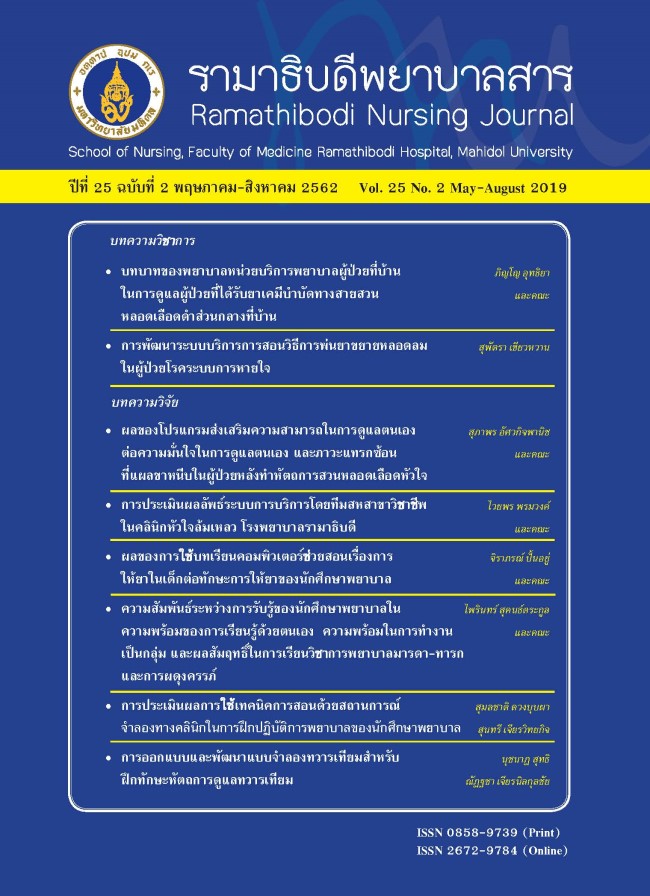The Effect of Computer-Assisted Instruction of Pediatric Medication Administration on Medication Administration Skills among Nursing Students
Main Article Content
Abstract
The present quasi-experimental research aimed to examine the effect of the computer-assisted instruction of pediatric medication administration on medication skills among nursing students. The study samples were the third-year nursing students from Ramathibodi School of Nursing in Faculty of Medicine Ramathibodi Hospital, Mahidol University. Eighty-eight of those students were selected using purposive sampling and randomly divided into two groups: a control group and an experimental group. Forty-two students in the control group were received the regular lessons, whereas forty-six students in the experimental group were received both regular lessons and the computer-assisted instruction of pediatric medication administration. The employed research instrument was the computer-assisted instruction of pediatric medication administration developed by the researchers and approved lesson contents by professional people. Data were collected using the assessment of pediatric medication administration and the evaluation for the satisfaction of the computer-assisted instruction. Data regarding demographic characteristics of the sample were analyzed using descriptive statistics, and data regarding the comparison of medication skills between the control group and the experimental group were analyzed using independent t-test. The correlation of medication skills in the experimental group before receiving the lessons, immediately and six weeks later after receiving the lessons were analyzed using linear mixed models.
The study findings showed that most of the student samples both the control group and the experimental group were female, and there was no significant difference in sample characteristics in both groups (p > .05). After learning pediatric medication administration, total scores of medication administration skills in the experimental group were higher than the control group with statistical significance at 0.01 level. In the experimental group, medication skills of enteral medication preparation, administration of medication via saline lock, intradermal, intramuscular, eye drops and ear drops administration, along with total scores of medication administration skills after receiving the lessons immediately and six weeks later were higher than that of before accepting the teaching with statistically significant at p < .01. Overall findings indicated that the student samples had high satisfaction on the computer-assisted instruction of pediatric medication administration. Therefore, computer-assisted instruction is an important tool in improving the quality of teaching and learning to be more effective.
Article Details
บทความ ข้อมูล เนื้อหา รูปภาพ ฯลฯ ที่ได้รับการตีพิมพ์ในรามาธิบดีพยาบาลสาร ถือเป็นลิขสิทธิ์ของวารสาร หากบุคคลหรือหน่วยงานใดต้องการนำทั้งหมดหรือส่วนหนึ่งส่วนใดไปเผยแพร่หรือเพื่อกระทำการใด ใด จะต้องได้รับอนุญาตเป็นลายลักษณ์อักษรจากรามาธิบดีพยาบาลสารก่อนเท่านั้น
References
of the nursing curriculum by Nursing and Midwifery
Council in 2016. [cited 2019 June 23]. Available from:
https://www.tnmc.or.th
2. Royal Thai Government Gazette. Standards of higher
education in 2018; 2018 [cited 2018 August 31].
Available from: https://www.ratchakitcha.soc.go.th/
DATA/PDF/2561/E/199/T19.PDF
3. Office of the Higher Education Commission. Term of
reference; 2018 [cited 2019 March 19]. Available from:
https://www.mua.go.th/users/bhes/pdf
4. Clark RE. Evidence for confounding in computer-based
instruction studies: analyzing the meta-analyses. ECTJ.
1985;33(4):249-62.
5. Prasarnsai W. Computer assisted instruction: innovation
for education. Bangkok; Thray Printing; 2004. (in Thai)
6. Mamom J. Computer assisted instruction (CAI):
educational technology to develop the knowledge and skills
of nursing students. Thai Science and Technology Journal.
2014:286-93. (in Thai)
7. Damkliang J, Nakdam P, Prasartvankit A, Promtape N.
Effects of computer assisted instruction entitled “Suturing”
on nursing students’ knowledge, practical skill and
satisfaction. The Journal of Faculty of Nursing Burapha University. 2010;18(1):56-67. (in Thai)
8. Somnarin O, Boonkusol T. The effect of computer assisted
instruction with thoracic examination on learning outcome
and satisfaction in nursing students. Journal of
Boromarajonani College of Nursing. 2016;32(2):94-
103. (in Thai).
9. Mamom J. Outcomes of computer mediated review lesson
on pressure sore dressing as observed in second-year
nursing students’ knowledge, practical skills and opinions.
TJNC. 2013;27(3):63-76. (in Thai)
10. Chatchaisucha S, Jitramontree N, Vanicharoenchai V. The
effect of an intravenous infusion E-material on the second
year nursing students’ ability to demonstrate the procedure
of intravenous infusion. J Nurs Sci. 2011;29(Suppl2):
143-50. (in Thai)
11. Chaimanee T, Disataporn C, Rojsomrith W, Aunming R.
The effectiveness of computer based simulation via internet
on practice guidelines prevention of nosocomial infection
for nursing Students. Veridian E-Journal, Silpakorn
University. 2017;10(1):565-81. (in Thai)
12. Kitrungrote L, Sae-Sia W, Khupantavee N. The effects
of computer assisted instruction program on wound
dressing knowledge and skills of nursing students.
Songklanakarin Journal of Social Sciences & Humanities,
2010;16(3):398-406. (in Thai)
13. Ragasa CY. A comparison of computer-assisted instruction
and the traditional method of teaching basic statistics. JSE.
2008;16(1):1-11.
14. Ramathibidi School of Nursing. Innovation. [cited 2019
June 23]. Available from: https://www.med.mahidol.
ac.th/nursing/research-ns/Innovation (in Thai)
15. Erb-arb S, Leevirat S. Effects of computer-assisted
instruction for aerosol administration therapy in children
on nurses’ knowledge and medication management skills
and on children’s respiratory response. TJNC. 2014;
29(4):105-20. (in Thai)
16. Dreber MA., Caputi L. The integration of theoretical
constructs into the design of computer assisted instruction.
Comput Nurs. 1992;10(5):219-24.
17. Vandeveer M, Norton B. From teaching to learning:
Theoretical foundation. In: Halstead JA, editor. Teaching
in Nursing. St. Louis: Elsevier-Saunders; 2005, p. 237-
41.
18. Keller, JM. (2006). Keller’s ARCS model of motivational
design. [cited 2019 June 23]. Available from: http//
www.arcsmodel.com
19. Skinner BF. Skinner’s Principle of Operant condition;
2006 [cited 2018 November 21]. Available from: http//
www. psychologyfacts.blogspot.com/what-is-operantconditioning.
html
20. Chaweethamawat A. Development of computer-assisted
instruction on knowledge of congenital heart diseases for
school-age children with congenital heart disease.
[Thesis]. Thailand, Mahidol University; 2012. (in Thai)
21. Koo T. K., & Li M. Y. A Guideline of Selecting and
Reporting Intraclass Correlation Coefficients for Reliability
Research. Journal of Chiropractic Medicine. 2016;
15(2),155-63.
22. Jinwan W. Application of cognitive loading theory and
online instructional design. JVTE. 2011;(1),19-24.
23. Bunprasert W. The development of computer-assisted
instruction lesson on the instruction intermittent
catheterization in male patient for nursing students Mahidol
University. Veridian E-Journal, Silpakorn University
2012;5(2): 183-92. (in Thai)
24. Tupanich W, Krajangdan S. Effectiveness of computerassisted
instruction on home health care for nursing students
of Kuakarun Faculty of Nursing. Kuakarun Journal of
Nursing. 2014; 21(2):198-210. (in Thai)


